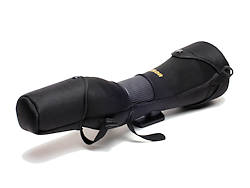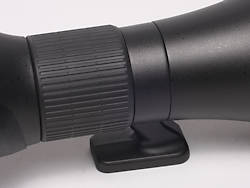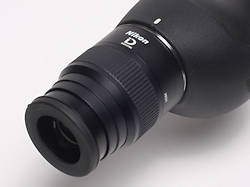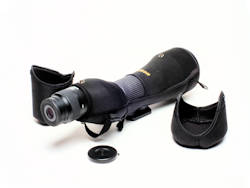Nikon Monarch ED Scopes
|
|
Review Highlights
- Nikon’s new full-sized, mid-priced, ED glass Fieldscope
- Bright views and sharp image quality
- Padded view-through case for added protection
|
The Monarch 20-60x82 ED Fieldscope is Nikon’s latest entry into what we
think of as the “mid-priced” scope market - scopes that offer a nice combination of reliable, high optical performance but at a price significantly lower than the truly high-end spotting scopes.
In case you don’t happen to speak scope, let’s review what the name tells us. Monarch is a Nikon brand, better known as one of the world’s best-selling binoculars, but also encompassing other
product lines: rifle scopes, range finders, etc. Basically, it tells you that this is a mid-level entry product for its class, neither a starter line, nor the top of the line. The top-of-the-line
Nikon spotting scope is the EDG Fieldscope. The 20-60 part tells you the magnification range of this scope: 20 to 60x.
The “S” tells you that this is a straight configuration scope, meaning the eyepiece extends more or less straight out towards the user from the scope body. There is an angled version: the
Monarch 20-60x82-A scope. There is no difference in either price or performance
between these two configurations: both cost $1,599.95 with the 20-60x eyepiece included. The “ED” stands for Extra-low
Dispersion glass, which is higher quality glass with enhanced optical properties, greater clarity, less distortion, lower chromatic aberration, and so on. ED glass is essential in all good
quality scopes, but there are many types of ED glass and they’re not all equal. Nikon has had their own proprietary source of ED glass for years, and theirs is pretty darn good. We received only
the Monarch 82-S configuration for review, so pretty much everything from this point on is specific to that particular model.
Physical Properties
 The Monarch 82-S Fieldscope is 15.75 inches (about 40 cm) long from ocular to objective lens with the 20-60 zoom eyepiece in place and the eyecup on that eyepiece folded in. It is about 4.75 inches
(~12 cm) tall from the top of the flared barrel or the eyepiece to the mounting bracket base. This Fieldscope weighs about 4.6 pounds (roughly 2.4 kg) and the neoprene view-through case adds another
0.5 pounds. The scope is coated in robust, matte black rubber armor, a significant contributor to the weight, along with the metal frame beneath and the ED glass, which is denser and heavier than
regular glass. And there’s 82 mm of ED glass in the objective lens alone, and other lenses through the tube. In case you’re wondering, these dimensions and weight characteristics are really pretty
much middle of the road for this class of scope, neither the heaviest, nor the biggest. The one interesting trait is the mounting bracket, which does extend below the frame of the scope an unusual
distance. As is usually the case with such brackets, on the Monarch 82-A version, it attaches to a collar within which the scope body rotates to offer views to people of varying height. Scope position
on the 82-A model is held with a set screw. The Monarch scopes come with an extendable lens hood on the objective end. This is a slide-out shade that extends out over the objective lens. Using it
reduces flare, but it also offers a bit of protection if the scope is tipped over. Better to break the hood than the objective lens! Our advice is always use the hood, all the time. As it happens,
the Nikon hood is very well-executed, sliding into place in either direction with great ease, and staying where you put it until you move it. Like all high-end optics these days, the Monarch
Fieldscope bodies are sealed, nitrogen-purged, and waterproof/fog-proof. The eyepieces, however, are not. The scope, according to Nikon literature, is designed to be waterproof when the eyepiece is
attached, but they also warn that it’s best to remove/switch eyepieces in as low humidity an area as possible.
The Monarch 82-S Fieldscope is 15.75 inches (about 40 cm) long from ocular to objective lens with the 20-60 zoom eyepiece in place and the eyecup on that eyepiece folded in. It is about 4.75 inches
(~12 cm) tall from the top of the flared barrel or the eyepiece to the mounting bracket base. This Fieldscope weighs about 4.6 pounds (roughly 2.4 kg) and the neoprene view-through case adds another
0.5 pounds. The scope is coated in robust, matte black rubber armor, a significant contributor to the weight, along with the metal frame beneath and the ED glass, which is denser and heavier than
regular glass. And there’s 82 mm of ED glass in the objective lens alone, and other lenses through the tube. In case you’re wondering, these dimensions and weight characteristics are really pretty
much middle of the road for this class of scope, neither the heaviest, nor the biggest. The one interesting trait is the mounting bracket, which does extend below the frame of the scope an unusual
distance. As is usually the case with such brackets, on the Monarch 82-A version, it attaches to a collar within which the scope body rotates to offer views to people of varying height. Scope position
on the 82-A model is held with a set screw. The Monarch scopes come with an extendable lens hood on the objective end. This is a slide-out shade that extends out over the objective lens. Using it
reduces flare, but it also offers a bit of protection if the scope is tipped over. Better to break the hood than the objective lens! Our advice is always use the hood, all the time. As it happens,
the Nikon hood is very well-executed, sliding into place in either direction with great ease, and staying where you put it until you move it. Like all high-end optics these days, the Monarch
Fieldscope bodies are sealed, nitrogen-purged, and waterproof/fog-proof. The eyepieces, however, are not. The scope, according to Nikon literature, is designed to be waterproof when the eyepiece is
attached, but they also warn that it’s best to remove/switch eyepieces in as low humidity an area as possible.
Optical Performance
 Overall, we were quite satisfied with the optical performance of this scope. We tested it against two other ED glass scopes in the 80-85 mm class, one of which costs about the same, and the other
of which was roughly $400 more expensive. In basic tests of sharpness, the Monarch Fieldscope fairly clearly and decisively outperformed the competitor scopes. We found the colors to be bright and
true without any detectable bias. Brightness is always a bit hard to assess in a quantitative way. We found the brightness to be acceptable without being super-amazing or anything. We were a little
less happy with the depth of field which initially seemed rather shallow on the Nikon. Then we looked at the other two scopes and realized that the Monarch was again better than they were! Still not
maybe what we would have liked, but definitely best in the limited class we tested. One experience we had common to all three in which none exceeded the others was in how fast the optical quality falls
off with advancing zoom magnification. We’ve all experienced this: even in very high-end spotting scopes, zoom eyepieces suffer a drop-off in sharpness and light-throughput at higher magnifications.
What we noted about the Nikon was that this fall-off was somewhat pronounced by about 45x even under perfect viewing conditions without detectable heat shimmer. Minimum close focus on the Monarch
Fieldscope at 20x was just a bit over 16 feet, exactly as listed by the Nikon literature. Generally, you don’t buy a scope to view something at that close distance, so maybe this isn’t all that important,
though it occasionally comes into play in the field. Nikon lists the field of view at 1000 yards and 20x magnification as being about 111 feet. Again, more field of view is always nice, but the point of
a scope is visual details: what you’re seeing well, not how much of the horizon you can see. And as long as seeing well is on the table for discussion, it’s worth noting that like many new optics, Nikon
has employed the field flattener lenses to provide edge-to-edge sharpness without dramatic difference between the center and the edge of the visual field. We were quite satisfied with its performance in
this regard. Monarch Fieldscopes focus with a helical collar mechanism that has remained unchanged on Nikon spotting scopes for as long as we can remember. There are advantages and disadvantages to this
mechanism. We found that, at least when new, the Monarch scope had a fair amount of resistance in it. This is good in that you are unlikely to inadvertently ‘bump’ it out of focus – it stays where you put
it. But we had some difficulty with it during testing because it was so stiff that adjusting it caused a full-sized tripod to shake enough that it was difficult to tell when maximum sharpness had been
achieved. This meant a certain amount of jockeying around every time one focused. And the when the view-through padded case is added, this gets worse because the ribbing of the focus collar rubs on the
case, increasing the resistance while at the same time impeding physical manipulation of the collar. However, unlike most scope focusing mechanisms, this one comes with an unexpected twist: variable speed
focusing. What does that mean? Variable speed focusing means that the rate at which the image focuses in response to turning the collar changes depending upon how far you are from the subject on which you
are focusing. This mechanism has three speeds: very fast/coarse for distant subjects, somewhat slower/finer for subjects at middle distance, and very slow/fine for very near subjects. This takes a little
getting used to, but once you do, it’s really excellent! Variable speed focusing is not a new concept, but it‘s a definite plus to have, and we heartily applaud Nikon for building it into the Monarch scopes.
Overall, we were quite satisfied with the optical performance of this scope. We tested it against two other ED glass scopes in the 80-85 mm class, one of which costs about the same, and the other
of which was roughly $400 more expensive. In basic tests of sharpness, the Monarch Fieldscope fairly clearly and decisively outperformed the competitor scopes. We found the colors to be bright and
true without any detectable bias. Brightness is always a bit hard to assess in a quantitative way. We found the brightness to be acceptable without being super-amazing or anything. We were a little
less happy with the depth of field which initially seemed rather shallow on the Nikon. Then we looked at the other two scopes and realized that the Monarch was again better than they were! Still not
maybe what we would have liked, but definitely best in the limited class we tested. One experience we had common to all three in which none exceeded the others was in how fast the optical quality falls
off with advancing zoom magnification. We’ve all experienced this: even in very high-end spotting scopes, zoom eyepieces suffer a drop-off in sharpness and light-throughput at higher magnifications.
What we noted about the Nikon was that this fall-off was somewhat pronounced by about 45x even under perfect viewing conditions without detectable heat shimmer. Minimum close focus on the Monarch
Fieldscope at 20x was just a bit over 16 feet, exactly as listed by the Nikon literature. Generally, you don’t buy a scope to view something at that close distance, so maybe this isn’t all that important,
though it occasionally comes into play in the field. Nikon lists the field of view at 1000 yards and 20x magnification as being about 111 feet. Again, more field of view is always nice, but the point of
a scope is visual details: what you’re seeing well, not how much of the horizon you can see. And as long as seeing well is on the table for discussion, it’s worth noting that like many new optics, Nikon
has employed the field flattener lenses to provide edge-to-edge sharpness without dramatic difference between the center and the edge of the visual field. We were quite satisfied with its performance in
this regard. Monarch Fieldscopes focus with a helical collar mechanism that has remained unchanged on Nikon spotting scopes for as long as we can remember. There are advantages and disadvantages to this
mechanism. We found that, at least when new, the Monarch scope had a fair amount of resistance in it. This is good in that you are unlikely to inadvertently ‘bump’ it out of focus – it stays where you put
it. But we had some difficulty with it during testing because it was so stiff that adjusting it caused a full-sized tripod to shake enough that it was difficult to tell when maximum sharpness had been
achieved. This meant a certain amount of jockeying around every time one focused. And the when the view-through padded case is added, this gets worse because the ribbing of the focus collar rubs on the
case, increasing the resistance while at the same time impeding physical manipulation of the collar. However, unlike most scope focusing mechanisms, this one comes with an unexpected twist: variable speed
focusing. What does that mean? Variable speed focusing means that the rate at which the image focuses in response to turning the collar changes depending upon how far you are from the subject on which you
are focusing. This mechanism has three speeds: very fast/coarse for distant subjects, somewhat slower/finer for subjects at middle distance, and very slow/fine for very near subjects. This takes a little
getting used to, but once you do, it’s really excellent! Variable speed focusing is not a new concept, but it‘s a definite plus to have, and we heartily applaud Nikon for building it into the Monarch scopes.
Eyepieces
 The Monarch 82-S Fieldscope comes with the 20-60x zoom eyepiece standard. Like most modern scope eyepieces, this one has an eye relief adjustment on the eyecup. Twisting it clockwise improves the quality
of view for those needing longer eye relief (i.e. – those who don’t wear glasses) while turning it all the way counter-clockwise is usually better for eyeglass wearers. Not everyone’s eyes are the same,
but that’s the most common pattern of effect. The eyecup adjustment is all or nothing – there are no intermediate positions. Nikon also offers two optional eyepieces for the Monarch scopes: a 38-mm wide-angle
eyepiece and a 30-60x zoom eyepiece option. We did not receive these for review so cannot comment about their quality, but you may wish to know they are out there. Eye relief on the 20-60x zoom at 20x is
about 16 mm.
The Monarch 82-S Fieldscope comes with the 20-60x zoom eyepiece standard. Like most modern scope eyepieces, this one has an eye relief adjustment on the eyecup. Twisting it clockwise improves the quality
of view for those needing longer eye relief (i.e. – those who don’t wear glasses) while turning it all the way counter-clockwise is usually better for eyeglass wearers. Not everyone’s eyes are the same,
but that’s the most common pattern of effect. The eyecup adjustment is all or nothing – there are no intermediate positions. Nikon also offers two optional eyepieces for the Monarch scopes: a 38-mm wide-angle
eyepiece and a 30-60x zoom eyepiece option. We did not receive these for review so cannot comment about their quality, but you may wish to know they are out there. Eye relief on the 20-60x zoom at 20x is
about 16 mm.
Peripherals
 The major peripherals on this scope are the case, lens caps, hood and digiscoping adaptors. We really liked the double-pinch clasp on the objective lens cover. It was easy to apply this cap and it
stayed in place admirably well. When deployed, the hood slides smoothly out over the lens cap, leaving it in place. We were less pleased with the ocular lens cap, which is made of semi-flexible plastic,
and fits only somewhat snugly over the rubber ring of the eyecup. It’s a bit precarious and it could be lost fairly easily in the field. There is a small flange with a hole in it on the rim of the
cap, presumably allowing one to affix a line of some sort to attach to the scope body to prevent such loss. We couldn’t find any place on the scope body to attach it to. You may have to work this one
out for yourselves! The view-through case is a hybrid of neoprene rubber and cordura fabric that covers from the base of the eyepiece to the end of the scope. On both ends, there are two snaps that
hook to cylindrical, padded cordura cups that snap onto and over the ends. It’s functional enough, but we found the cups got a bit annoying in the field sometimes, and because they are detachable,
it’s also possible to lose them. The case also comes with a set of dual strap attachment brackets, and a padded strap comes standard with the case. This means that when in transit, you can detach
the scope from the tripod and carry them separately, thereby reducing weight on the shoulder during transit. That’s a plus. On the flip side, of course, is that you have to attach the scope each time
before you use it, and if you are forced to deploy quickly in the field, you could end up missing something. It’s your call ultimately. Lastly, Nikon does offer digiscoping attachments that allow
you to attach a digital camera and take pictures through your scope. We did not receive one for evaluation, so we cannot say how effective or easy to use they are. But again, they’re out there, and
you can explore them at your wish.
The major peripherals on this scope are the case, lens caps, hood and digiscoping adaptors. We really liked the double-pinch clasp on the objective lens cover. It was easy to apply this cap and it
stayed in place admirably well. When deployed, the hood slides smoothly out over the lens cap, leaving it in place. We were less pleased with the ocular lens cap, which is made of semi-flexible plastic,
and fits only somewhat snugly over the rubber ring of the eyecup. It’s a bit precarious and it could be lost fairly easily in the field. There is a small flange with a hole in it on the rim of the
cap, presumably allowing one to affix a line of some sort to attach to the scope body to prevent such loss. We couldn’t find any place on the scope body to attach it to. You may have to work this one
out for yourselves! The view-through case is a hybrid of neoprene rubber and cordura fabric that covers from the base of the eyepiece to the end of the scope. On both ends, there are two snaps that
hook to cylindrical, padded cordura cups that snap onto and over the ends. It’s functional enough, but we found the cups got a bit annoying in the field sometimes, and because they are detachable,
it’s also possible to lose them. The case also comes with a set of dual strap attachment brackets, and a padded strap comes standard with the case. This means that when in transit, you can detach
the scope from the tripod and carry them separately, thereby reducing weight on the shoulder during transit. That’s a plus. On the flip side, of course, is that you have to attach the scope each time
before you use it, and if you are forced to deploy quickly in the field, you could end up missing something. It’s your call ultimately. Lastly, Nikon does offer digiscoping attachments that allow
you to attach a digital camera and take pictures through your scope. We did not receive one for evaluation, so we cannot say how effective or easy to use they are. But again, they’re out there, and
you can explore them at your wish.
Conclusions
Generally, we were very happy with the Monarch 82-S Fieldscope performance. It definitely outclassed the competition in direct tests of most things that matter in a scope. Our complaints about it are,
after all, somewhat nit-picky, and though accurate, they may not really be about things that matter overly much. Clearly, the niche for this scope is the birder on a moderate budget, able to afford
something good but not going for the very peak of available scope performance. And of the scopes we’ve seen in this class, this one seems to exceed others in its cohort. So if you’re looking for a
mid-priced full-sized ED-glass spotting scope, the Monarch Fieldscope seems like a very solid choice.
Buy Nikon
Monarch ED Spotting Scopes